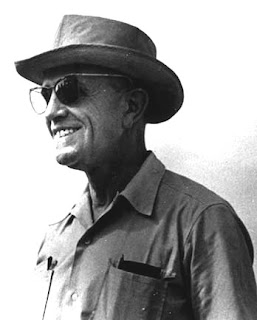
Reimar and Walter Horten
Walter (13 November 1913 - 9 December 1998 Baden-Baden) and Reimar Horten (12 March 1915 - 14 March 1994 Villa General Belgrano, Argentina), sometimes credited as the Horten Brothers, were German aircraft pilots and enthusiasts. Though they had little, if any, formal training in aeronautics or a related field, the Hortens designed some of the most advanced aircraft of the 1940s.
Between the World Wars, the Treaty of Versailles limited the construction of German military airplanes. In response, German military flying became semi-clandestine, taking the form of civil 'clubs' where students trained on gliders under the supervision of decommissioned World War I veterans. As teenagers, the Horten brothers became involved in such flying clubs.
This back-to-the-basics education, and an admiration of German avant-aircraft designer Dr. Alexander Lippisch, led the Hortens away from the dominant design trends of the 1920s and '30s, and toward experimenting with alternative airframes -- building models and then filling their parents' house with full-sized wooden sailplanes. The first Horten glider flew in 1933, when both brothers were still in their teens.
The Hortens' glider designs were extremely simple and aerodynamic, generally consisting of a huge, tailless albatross-wing with a tiny cocoon of a fuselage, in which the pilot lay prone. But the great advantage of the Horten designs was the extremely low parasitic drag of their airframes. They were 'slick' and scalable to high speeds.
By 1939, with Adolf Hitler in power and the Treaty of Versailles no longer in effect, Walter and Reimar had entered the Luftwaffe as pilots. (A third brother, Wolfram, was killed flying a bomber over Dunkirk.) They were also called upon as design consultants, though Germany's aeronautical community tended to regard the Hortens not as part of the cultural elite.
In 1937, the Hortens began using motorized airplanes, with the debut of the twin-engined pusher-prop airplane H.VII (an earlier glider had a mule engine). The Luftwaffe, however, did not actually use many of the Hortens' designs until 1942, when grudging (and partly under-the-table) support was given to a twin-turbojet-powered fighter/bomber design, designated under wartime protocols as the Horten H.IX.
The Horten Ho 229, the world's first jet-powered flying wingSecuring the allocation of turbojets was difficult in wartime Germany, as other projects carried higher priority due to their rank in the overall war effort. Although the turbojet-equipped Ho IX V2 nearly reached a then-astonishing 500 mph in trials, the project was soon given over to the theretofore low-tech aircraft company, Gothaer Waggonfabrik, as the Horten Ho 229 (subsequently often erroneously called Gotha Go 229).
The Ho 229 was a fighter jet with great potential, but arrived too late to see service. Among other advanced Horten designs of the 1940s was the supersonic delta-wing H.X, designed as a hybrid turbojet/rocket fighter with a top speed of Mach 1.4, but tested only in glider form (as the Horten H.XIII). Its revolutionary stealth design included a special carbon layer that was able to reduce the radar range detection. The Horten brothers also worked on the Horten H.XVIII, an intercontinental bomber that was part of the Amerika Bomber project.
As the war ended, Reimar Horten emigrated to Argentina, where he continued designing and building gliders and one twin-engined flying wing transport, which was unsuccessful commercially. Walter remained in Germany after the war and became an officer in the post-war German Air Force Luftwaffe. Reimar died on his ranch in Argentina in 1994, while Walter died in Germany in 1998.
In the late 1940s, the personnel of Project Sign, the U.S. Air Force's flying saucer investigation, seriously considered the possibility that UFOs might have been secret aircraft manufactured by the U.S.S.R. based on the Hortens' designs





























